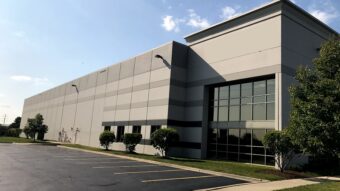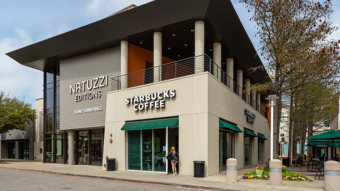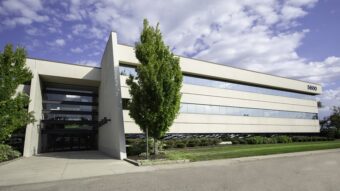“It’s not easy bein’ green,” Kermit the Frog once sang. For industrial development, that can still be true.
Since the sustainable movement first took hold in the building industry, it has slowly become more mainstream. These days, most large developments, from office to multifamily, have integrated energy-saving and other green features as a default.
But new industrial projects can be tough to develop with the same rigor. USGBC’s LEED rating system has seen number of updates over the years, pushing the industry to construct and operate more efficiently. LEED v4—the latest version announced in 2013 and in full effect since 2016—further stressed traits usually found in dense, urban environments.
“It’s not super conducive for warehouses,” said Steve Golumbeck, vice president of Peak Construction. “A farm field turned into a building isn’t what LEED is pushing for.”
Depending on where a project is located, some LEED credits are tap-ins. Things like access to public transportation or reduced parking are highly achievable in a downtown environment. Warehouses and manufacturing facilities, which typically go up on exurban greenfield sites, are playing from the rough before ground ever breaks.
So building a new, sustainable industrial building is hard, but far from impossible. Golumbeck should know; he’s worked on quite a few.
In 2016, Sunstar, a global manufacturer of healthcare and cosmetics products, was looking to create a new North American headquarters, consolidating its two locations in Elgin and Chicago. The result was a build-to-suit, 302,000-square-foot office and manufacturing facility in Schaumburg.
Designed by Heitman Architects and built by Peak Construction, the LEED certified building makes use of several energy conservation measures. A high-performance envelope regulates temperature fluctuations while the site’s energy use was reduced via power density reduction and occupancy controls on interior and exterior lighting.
High-efficiency mechanical equipment installations include building automation systems as well as pressure and CO2 sensors to modulate performance in the office and the warehouse and manufacturing areas.
Peak Construction completed another project in 2015, Building A in the Antioch Corporate Center. Certified LEED Silver, this 454,276-square-foot building was also designed by Heitman Architects and developed by IDI Logistics, the industrial property arm of Brookfield Property Partners.
The Antioch Corporate Center received LEED points for using recycled content and low-VOC (volatile organic compound) construction materials inside the building. Additionally, the energy model showed the building operating 24 percent better than a baseline warehouse.
Even though it’s not an infill, compact office tower in a densely populated environment, the typical new industrial building still has a number of green features at its disposal. Electric charging stations, for example, can extend the recharging infrastructure for electric vehicles.
Peak Construction is putting such a charging station into a warehouse they are working on currently in Bordentown, New Jersey. Developed by DCT Industrial—the firm recently acquired by Prologis—the 440,000 square foot speculative warehouse will make use of a number of green features.
“Where we were able to get lots of points is the energy and atmosphere,” Golumbeck said. “The biggest point we got was the optimized energy performance.”
Ownership for this project elected to put in LED lighting. While that has been the low-hanging-fruit of other green developments for years, it’s not entirely common in spec industrial buildings. They have a higher initial cost than T-5 fluorescent lights at close to the same efficiency. Financial and energy savings are recouped down the line because of lower maintenance.
“The payback comes, it just doesn’t come right away and speculative warehouses aren’t always interested in that long-term maintenance reduction,” said Golumbeck.
LEED’s sustainable sites category gives points to a project that mitigates unwanted interaction between a building and its surrounding ecosystem. This can include things like rainwater management and retention, light pollution reduction or habitat restoration. The New Jersey project makes use of bioswales and infiltration to reduce stormwater runoff that would otherwise lead to flooding or impact downstream waterways.
“The owner was willing to tweak the site and lose maybe a little square footage here and there to make sure that we had what LEED would consider a sustainable site,” Golumbeck said.
The last frontier for sustainability and industrial that seems as if it would be the perfect marriage is on-site solar power generation. Warehouses and fulfilment centers not only have massive footprints, there are typically no surrounding structures to cast shade on their expansive roofs. So why haven’t solar panels been installed atop these structures more frequently?
The main reason is funding. Even though the cost of solar has steadily fallen year after year, the standard industrial building requires beefed up structural steel to manage the additional dead loads.
“Between the additional cost of that and the solar panels themselves, it’s still not super competitive,” Golumbeck said. Owners aren’t willing to do it and there aren’t enough incentives here in the Midwest in order for it to be much of a viable solution.”
The USGBC announced a moderate update to LEED, v4.1, which will roll out later this year. Not much is known about the next version, though most of the changes are expected to be administrative.



